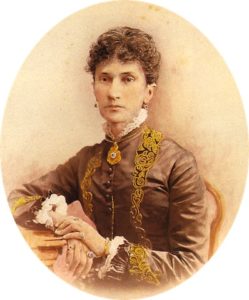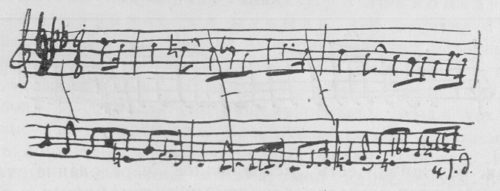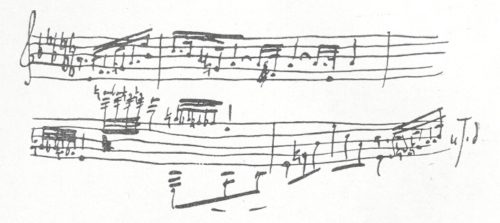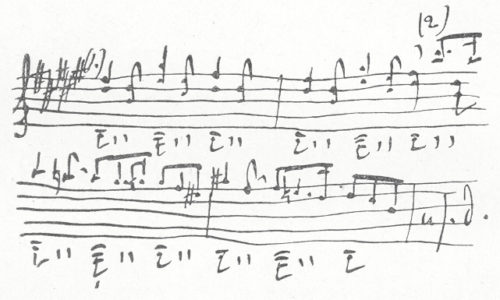
January 11, 2018
A Battle with Fate: Tchaikovsky’s Symphony No. 4

Not long after the triumphant St. Petersburg premiere of Tchaikovsky’s Fourth Symphony in 1878, the composer received a letter from a woman who had recently become one of the most important people in his life. Nadezhda von Meck was the immensely wealthy widow of one of Russia’s first railroad magnates, and was an ardent admirer of Tchaikovsky’s music. Over the course of 1877, she began sending him a generous stipend, allowing Tchaikovsky to abandon teaching and devote himself full-time to composition. In addition to money, she provided Tchaikovsky with a lively epistolary friendship on the condition that they never meet. In appreciation, Tchaikovsky had dedicated his new symphony to her, “my best friend.”
In her letter, she asked Tchaikovsky whether his latest work told some hidden story. Tchaikovsky responded that “Usually when this question is put to me about a symphonic work my answer is: none!” but that “In our symphony…it is possible to express in words what it is trying to say, and to you, and only to you…” The letter provides a fascinating insight into the composer’s conception of the piece.
The symphony opens with a powerful motif in the horns representing fate, “that fateful force which prevents the impulse to happiness from attaining its goal, which jealously ensures that peace and happiness shall not be complete and unclouded, which hangs above the head like the sword of Damocles, unwaveringly, constantly poisoning the soul. It is an invincible force that can never be overcome—merely endured, hopelessly.”
This leads to a melody in the violins which begins softly and plaintively, but soon grows into an anguished expression of suffering:
Suddenly, a shuffling, emotionally exhausted melody in the clarinet takes its place:
“Is it not better to escape from reality and to immerse oneself in dreams?” Tchaikovsky asks. A lilting, bleary-eyed melody appears in the violins:
“Out of nowhere a sweet and gentle day-dream appears. Some blissful, radiant human image hurries by and beckons us away.” The music grows and develops, leading to a passage that is as triumphant as the opening was despairing: “Everything gloomy and joyless is forgotten. Here it is, here it is—happiness!”
This cosmic joy is shattered when the opening fate motif reappears in the trumpets, as if from a battlefield:
“No! These were daydreams, and Fate wakes us from them.” Swirling variations on the suffering melody lead to a long crescendo full of intense longing. At its height, it is cut off by the fate motif. The ensuing orchestral chaos builds to a climactic return of the suffering melody. The daydreams and visions of happiness also reappear, but are ultimately vanquished by fate. Near the end, a sweetly nostalgic melody appears in the woodwinds, but darkens and becomes fitful, like a puppet on a string, as the fate motif arises from the brass. “And thus all life is an unbroken alternation of harsh reality with fleeting dreams and visions of happiness… No haven exists… Drift upon that sea until it engulfs and submerges you in its depths. That, roughly, is the program of the first movement.”
The second movement begins with an oboe solo that evokes “that melancholy feeling which comes in the evening when, weary from one’s toil, one sits alone with a book—but it falls from the hand. There comes a whole host of memories.” The melody is passed to the cellos, and ends with a glowing refrain. The melody returns with varied orchestration, leading to a warmer, more confident melody that grows increasingly frenzied, suggesting “Happy moments when the young blood boiled, and life was satisfying.” Tchaikovsky’s former student Sergei Taneyev remarked on the balletic nature of this section, and here it is easy to imagine a pair of dancers in a pas de deux, complete with a climactic lift.
The opening melody returns, leading to another contrasting section. The music sinks lower and lower, reaching a bleak nadir: “There are also painful memories, irreconcilable losses.” The bassoon gives a final reprise of the opening melody: “It is both sad, yet somehow sweet to be immersed in the past…”
The third movement gives “free rein to the imagination, which somehow begins to paint strange pictures…” Tchaikovsky compares the state of mind evoked to “the first phases of intoxication” or the “images which sweep through the head as one falls asleep.” The orchestration is highly original, featuring pizzicato strings. A contrasting middle section presents “a picture of drunken peasants and a street song” with the woodwinds, and the brass show “somewhere in the distance, a military procession” passing by.
The finale begins with a fortissimo rush of notes at breakneck speed. These musical fireworks conjure images of a public festival: “If within yourself you find no reasons for joy, then look at others…Picture the festive merriment of ordinary people.” This wild, celebratory music alternates with a Russian folk song, “In the Field a Birch Tree Stood,” in which a married woman sings to her lover (you can listen to the folk song here). The revelry continues until the fate motif of the first movement makes a dramatic reappearance: “Hardly have you managed to forget yourself and to be carried away by the spectacle of the joys of others, than irrepressible fate appears again and reminds you of yourself.” Gradually, the festive music returns: “But others do not care about you, and they have not noticed that you are solitary and sad. O, how they are enjoying themselves! How happy they are that all their feelings are simple and straightforward. Reproach yourself, and do not say that everything in this world is sad. Joy is a simple but powerful force. Rejoice in the rejoicing of others. To live is still possible.”
In a post-script, Tchaikovsky wrote: “Just as I was about to put the letter in an envelope, I re-read it and was horrified…I was severely depressed last winter when writing the symphony, and it serves as a faithful echo of what I was experiencing. But it is only as an echo. How can it be translated into a clear and coherent succession of words? I do not know how to do that. I have already forgotten so much…”
Tchaikovsky’s biographers have endlessly debated the relationship between “fate” and the composer’s homosexuality. Some believe that the symphony expresses Tchaikovsky’s guilt and shame over taboo desires he could not suppress, while others argue that Tchaikovsky fully accepted his orientation and was simply a gay man who struggled with bouts of depression unrelated to his sexuality. Whatever the case, he transformed his battle with fate into one of humanity’s most powerful works of art. —Calvin Dotsey
Hear the Houston Symphony perform Tchaikovsky’s Symphony No. 4 on January 25, 27 & 28 at Jones Hall. Get tickets and more information here.











